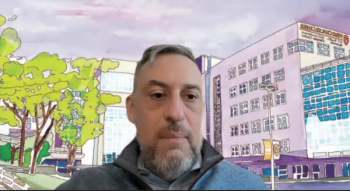
Therapeutic Advances in IPF and PPF: Toby Maher, MD, PhD

Key Takeaways
- Nerandomilast, a PDE4 inhibitor, has shown significant efficacy in progressive pulmonary fibrosis (PPF), offering an alternative to nintedanib and enabling combination therapy.
- The introduction of new antifibrotic agents may require adjustments in patient monitoring and care pathways, emphasizing early detection of disease progression.
New treatment options for idiopathic pulmonary fibrosis (IPF) and progressive pulmonary fibrosis (PPF) could enhance patient care and monitoring.
The treatment landscape for progressive pulmonary fibrosis (PPF)—previously limited to nintedanib—has been significantly broadened by positive FIBRONEER-ILD (
Toby Maher, MD, PhD, professor of clinical medicine and director of Interstitial Lung Disease at the Keck School of Medicine at the University of Southern California, discussed nerandomilast's potential in PPF and the future of IPF and PPF treatment in this interview with The American Journal of Managed Care® (AJMC®).
This transcript has been lightly edited.
AJMC: Based on the FIBRONEER-ILD trial data, how might nerandomilast be integrated into PPF management in the future?
Maher: For PPF, we've had one less treatment option—we've only had nintedanib as an approved therapy for this indication. If patients either haven't been able to take nintedanib or haven't tolerated nintedanib for whatever reason, then there's been no other option available for them. It’s great that we now have options.
The data in the FIBRONEER-ILD study were, if anything, more striking than they were in the FIBRONEER-IPF study. The relative benefit in terms of FVC decline was larger, and the benefits in terms of survival, hospitalization, and acute exacerbations were much more obvious in the ILD population, so I think the argument for using nerandomilast, potentially as a first-line treatment, is even stronger in this group of patients than it was in IPF. And as with IPF, we now have the option to use both drugs in combination as well.
AJMC: Does the introduction of a new class of antifibrotic agents necessitate changes to standard care pathways or patient monitoring?
Maher: On one hand, I don't think the change is as big as it was in 2014. In 2014, there weren't really care pathways set up for patients with IPF or other forms of pulmonary fibrosis. Over the last 10 years, we've seen the development of dedicated services for these patients. We've seen the involvement of other health care professionals, like nurses, respiratory therapists, social workers, and dieticians joining the management of these patients. I think all of that's been important. I think probably the biggest change is the fact that we now have combination treatment available to us. I think that will slightly change the monitoring of patients.
Historically, with only the 2 drugs available and given that they couldn't be used together, there were only limited options if patients were deteriorating, and one had to decide whether to stick with whichever drug you put them on or whether to make a change to the alternative. Now, it's going to be more important that we detect [disease] progression, because we're going to have the option to add combination treatments. We may want to more closely monitor our patients going forward than we have historically—although, on the flip side, I think it will be easier to prescribe medication, because, again, with pirfenidone and nintedanib, we've often had to help patients with lifestyle changes so that they could tolerate treatment, but I'm optimistic that we won't be needing to do as much of that with nerandomilast.
AJMC: Are there any novel targets or agents you’re excited about in the IPF or PPF pipelines?
Maher: I'm excited by anything that looks like it might be successful. I think the recent data published for [treprostinil] were very promising. I think we're all optimistic that that may be the fourth treatment that becomes available, and of course, that will provide even more options and even more challenges with decision-making. Similarly, admilparant, which is an LPA receptor one antagonist, is in the midst of phase 3 trials. And again, we're cautiously optimistic that that will also show positive benefit in patients with IPF.
Further down the line, there are 10 or 15 other drugs in development, and I would hate to pick out 1 of them, but I'm optimistic that with so many drugs in trials, hopefully 1 or 2 of them will come through in the not-too-distant future as further options.
AJMC: Are there any emerging biomarkers that could change how patients are diagnosed or predict who will benefit most from specific antifibrotic therapies?
Maher: Having spent the last 15 years of my life doing biomarker research, I would love to say yes, but it's not that easy. I think better use of imaging with AI-driven algorithms and biomarkers will certainly help us detect progression of fibrosis at an earlier stage, and I hope will also make it easier for community-based services to better monitor and diagnose interstitial lung disease in terms of blood biomarkers.
We have identified multiple biomarkers that track with disease progression, and several of them do change with treatment, but it's not the same ones that change with each treatment. Each of the 3 drugs seems to affect a slightly different panel of biomarkers, so we're still trying to work out how we might use those in clinical practice to correctly identify patients who are responding or not responding to treatments at an early stage. We're a little way away from using those.
Where we perhaps have more luck is in trying to identify patients who are at high risk of progressing in the near future. There's a biomarker signature that we will be testing in a Department of Defense–funded trial in the near future. I would also love to identify biomarkers that could help us pick the best treatment for each patient, but I think we're some way away from doing that.
Newsletter
Stay ahead of policy, cost, and value—subscribe to AJMC for expert insights at the intersection of clinical care and health economics.








































